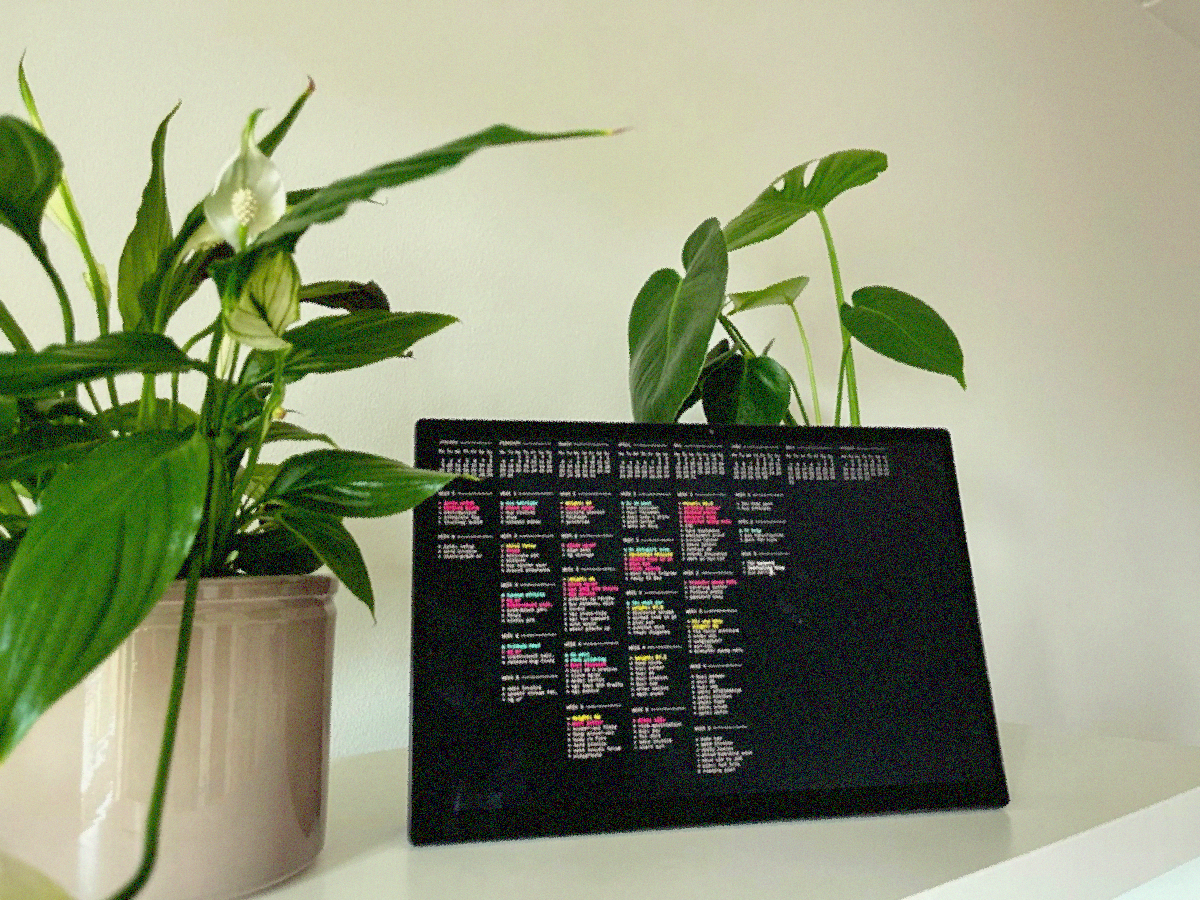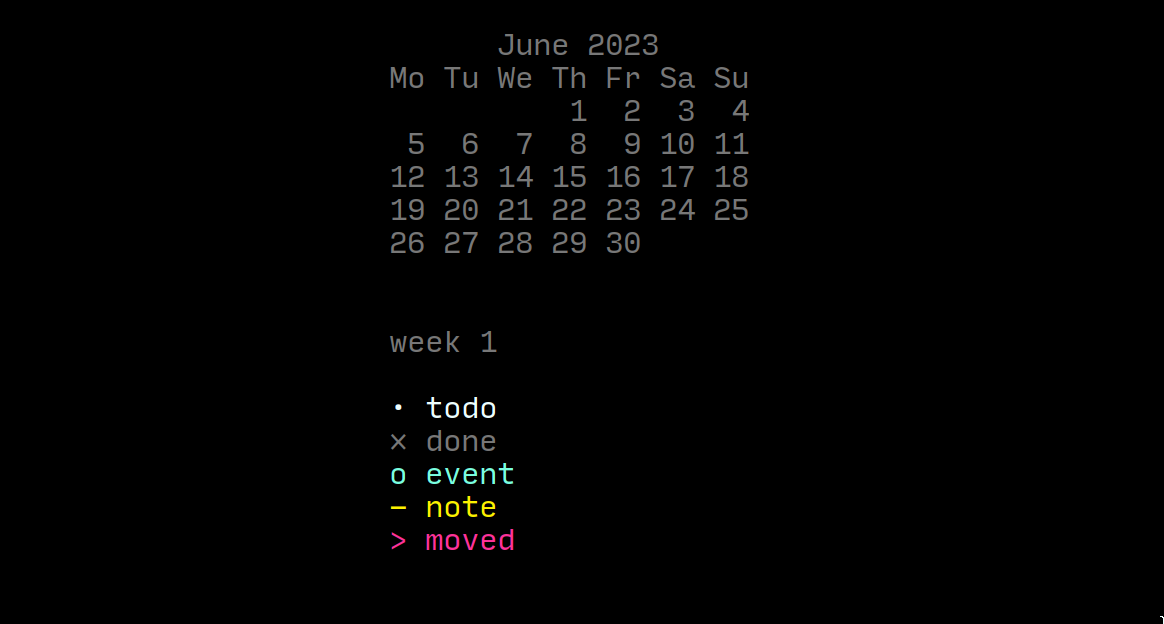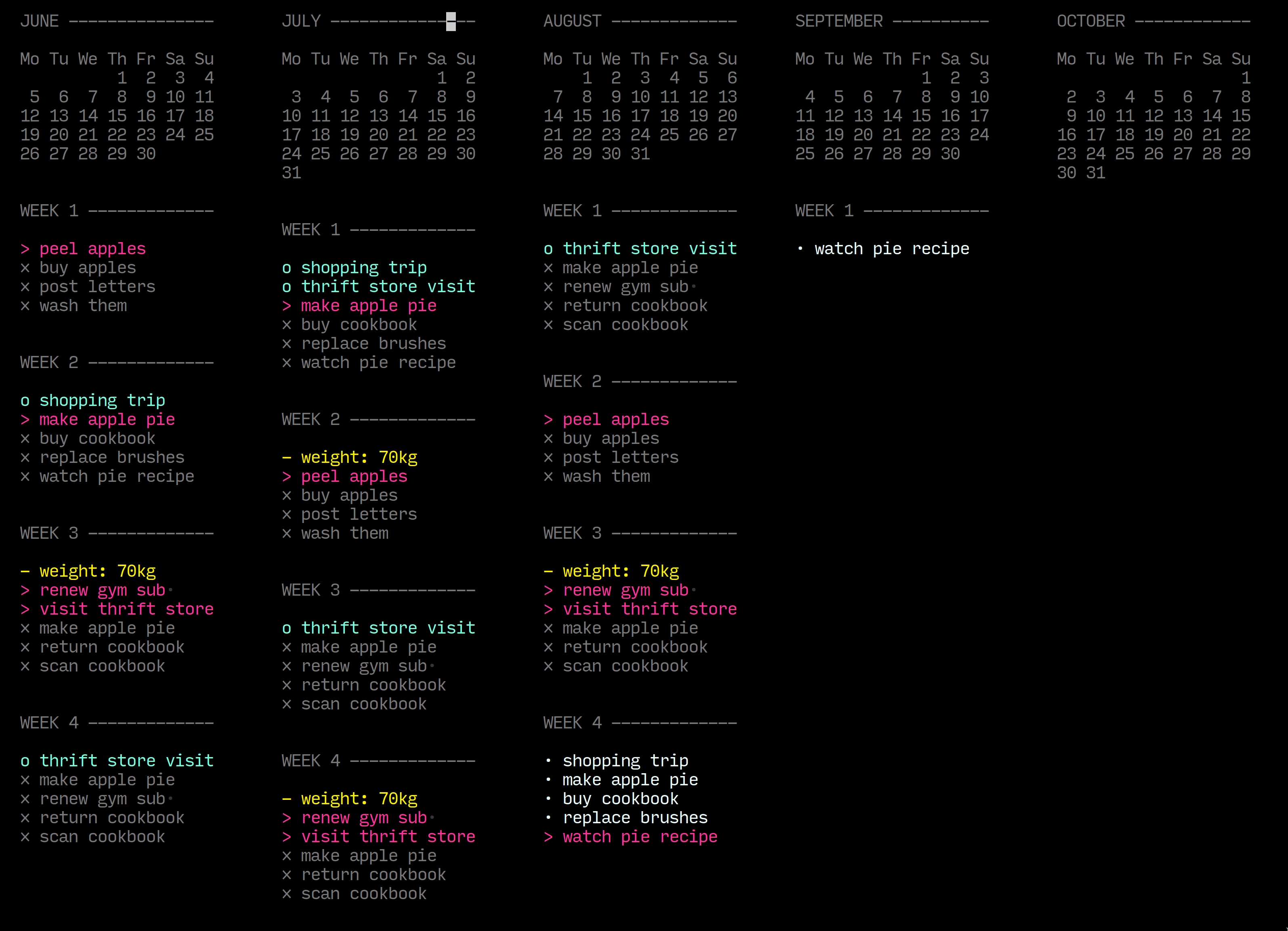Plain Text Journaling
I cobbled together a journaling system with {neo,}vim, coreutils and dateutils. This system is loosely based on Ryder Caroll’s Bullet Journal method.
The format
The journal for a given year is a directory:
λ ls journal/
2022/ 2023/In each directory are 12 files, one for each month of the year, numbered like so:
λ ls journal/2023/
01 02 03 04 05 06 07 08 09 10 11 12We can now begin writing stuff down:
λ vim journal/2023/1Every month must start with a calendar of course, fill that in with:
:read !cal -mYour entry for January might look like this:
λ cat journal/2023/01
January 2023
Mo Tu We Th Fr Sa Su
1
2 3 4 5 6 7 8
9 10 11 12 13 14 15
16 17 18 19 20 21 22
23 24 25 26 27 28 29
30 31I prefer planning week by week, as opposed to creating a task-list every day, here’s what I have for the first couple of weeks:
January 2023
Mo Tu We Th Fr Sa Su
1
2 3 4 5 6 7 8
9 10 11 12 13 14 15
16 17 18 19 20 21 22
23 24 25 26 27 28 29
30 31
week 1
done apply leaves
done dload boarding pass
moved reply to dan
week 2
todo reply to dan
todo pack bags
done travel insurance
todo weigh luggageI start the week by writing a header and each item that week is
placed on its own line. The items are prefixed with a todo
or a done signifier.
Form over function
Right off the bat, the signifiers look very noisy, Even more so once we start introducing variety (I use “event”, “note” and “moved”):
week 1
todo apply leaves
done dload boarding pass
todo reply to dan
event fr trip
note weight 68.6We can clean this up with “abbreviations”
(:h abbreviations):
:iabbrev todo ·
:iabbrev done ×Now, typing this:
todo apply leavesAutomatically inserts:
· apply leavesYou can use x and o as well, but
× (U+00D7, MULTIPLICATION SIGN) and · (U+00B7,
MIDDLE DOT) are more … gourmet.
The other signifiers I use are:
-for noteofor event>for moved.
Nit #2 is the lack of order. We can employ vim to introduce grouping and sorting. Select the list of entries for this week:
vip " line-wise select inner paragraph
:'<,'>sort " the markers '< and '> are automatically inserted,
" they mark the start and end of the selectionWe end up with:
week 1
· apply leaves
· reply to dan
× dload boarding passThe lines are grouped by their signifiers, segregating todo items
from completed items. Luckily, MIDDLE DOT is lesser than MULTIPLICATION
SIGN, so todo items are placed at the top. The same goes for
o and x symbols, either set of signifiers will
result in the same sorting order.
We can shorten this select-paragraph-invoke-sort dance by setting the
formatprg variable:
:set formatprg=sort\ -VNow, hitting gqip should automatically group and sort
the items for the week under the cursor, moving todo items to the top.
Finding signifier glyphs that suit your sorting preference is a fun
exercise.
Syntax highlighting
Adding color to items introduces another layer of visual distinction. In truth, I like to deck it out just because.
First, create a few syntax groups:
:syntax match JournalAll /.*/ " captures the entire buffer
:syntax match JournalDone /^×.*/ " lines containing 'done' items: ×
:syntax match JournalTodo /^·.*/ " lines containing 'todo' items: ·
:syntax match JournalEvent /^o.*/ " lines containing 'event' items: o
:syntax match JournalNote /^- .*/ " lines containing 'note' items: -
:syntax match JournalMoved /^>.*/ " lines containing 'moved' items: >Add highlights to each group:
:highlight JournalAll ctermfg=12 " bright black
:highlight JournalDone ctermfg=12 " bright black
:highlight JournalEvent ctermfg=6 " cyan
:highlight JournalMoved ctermfg=5 " magenta
:highlight JournalNote ctermfg=3 " yellowIn my terminal, this is rendered like so:
Habit tracking
While this is not a part of my journaling system anymore, a few headers and an awk script is all it takes to track habits. My weekly entries would include a couple of habit headers like so:
week 1 --------------
× wake up on time
× water the plants
spend 7.5 7 10
---------------------
week 2 --------------
· make the bed
· go to bed
spend 30 2.75 6
---------------------Here, under the spend header in week 1, are a list of
expenditures accumulated over the week. The monthly spend is calculated
with this awk script:
BEGIN {spend=0;}
/spend/ {for(i=1;i<=$NF;i++) spend+=$i;}
END { printf spend "eur"}And invoked like so:
λ awk -f spend.awk journal/2023/01
63.25eurReflection
Journaling is not just about planning what is to come, but also reflecting on what has passed. It would make sense to simultaneously look at the past few weeks’ entries while making your current one. To open multiple months of entries at the same time:
λ vim -O journal/2023/0{1,2,3}Opens 3 months, side-by-side, in vertical splits:
JANUARY ------------ │ FEBRUARY ----------- │ MARCH --------------
│ │
Mo Tu We Th Fr Sa Su │ Mo Tu We Th Fr Sa Su │ Mo Tu We Th Fr Sa Su
1 │ 1 2 3 4 5 │ 1 2 3 4 5
2 3 4 5 6 7 8 │ 6 7 8 9 10 11 12 │ 6 7 8 9 10 11 12
9 10 11 12 13 14 15 │ 13 14 15 16 17 18 19 │ 13 14 15 16 17 18 19
16 17 18 19 20 21 22 │ 20 21 22 23 24 25 26 │ 20 21 22 23 24 25 26
23 24 25 26 27 28 29 │ 27 28 │ 27 28 29 30 31
30 31 │ │
│ │
│ │
WEEK 1 ------------- │ WEEK 1 ------------- │ WEEK 1 -------------
│ │
> latex setup │ > forex │ - weight: 64
× make the bed │ × clean shoes │ > close sg-pr
× 03: dentist │ × buy clothes │ × facewash
× integrate tsg │ × draw │ × groceries
│ │
│ │
WEEK 2 ------------- │ WEEK 2 ------------- │ WEEK 2 -------------
│ │
× latex setup │ - viral fever │ > close sg-pr
× send invoice │ × forex │ × plan meet
× stack-graph pr │ × activate sim │ × sg storage
│ × bitlbee │Reducing friction
Journaling already requires a solid amount of discipline and
consistency. The added friction of typing
vim journal/$CURRENT_YEAR/$CURRENT_MONTH each time is doing
no favors.
To open the current month based on system time:
λ vim $(date +"%Y/%m")To open all the months within a 2 month window of today, is a little trickier. The command we wish to generate is (if today is 2023/12):
λ vim -O 2023/10 2023/11 2023/12 2024/01 2024/02And that is where dateseq from dateutils comes in handy, for
example:
λ dateseq 2012-02-01 2012-03-01
2012-02-01
2012-02-02
2012-02-03
...
2012-02-28
2012-02-29
2012-03-01This script opens all months within a 2 month window of today:
λ vim -O $(
dateseq \
"$(date --date "2 months ago" +%Y/%m)" \
"$(date --date "2 months" +%Y/%m)" \
-i %Y/%m \
-f %Y/%m
)Fin
You can find a sample vimrc file here: cli/journal, along with a nix flake file to kick things off.
Plain text journaling can be just as much fun as a pen and paper. Throw in some ASCII art for each month, use swankier signifiers, or louder syntax highlighting. Don’t expect forgiveness from org-mode users though.
I'm Akshay, programmer and pixel-artist.
I write open-source stuff to pass time. I also design fonts: scientifica, curie.
Send me a mail at [email protected] or a message at [email protected].


